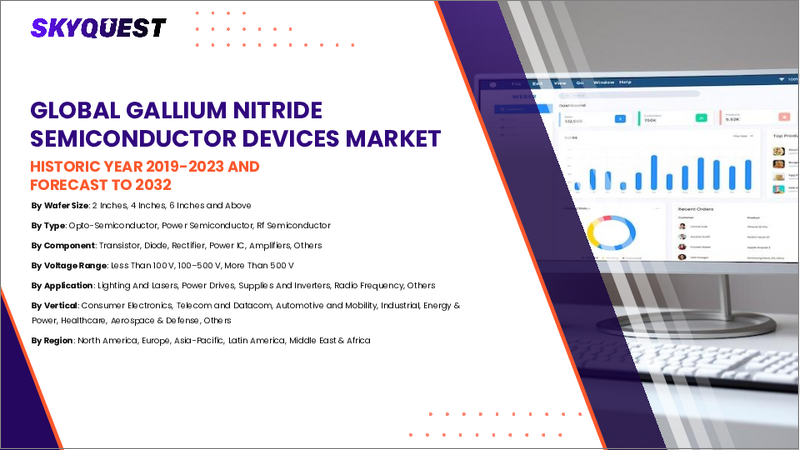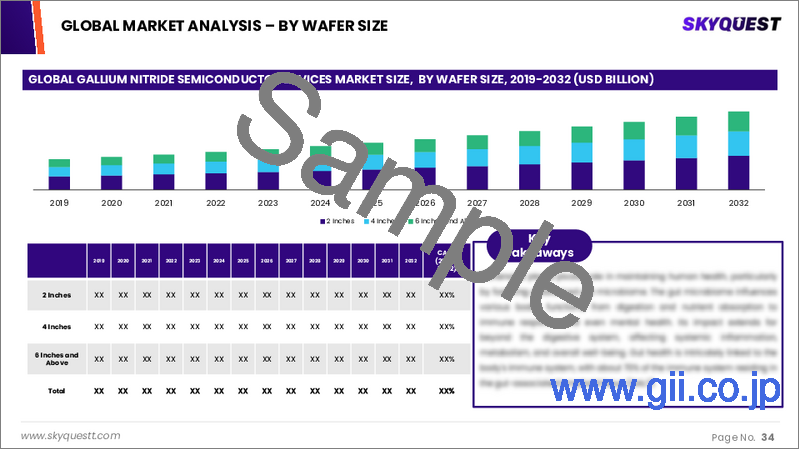|
|
市場調査レポート
商品コード
1663832
窒化ガリウム半導体デバイス市場規模、シェア、成長分析:製品別、部品別、ウエハーサイズ別、用途別、最終用途別、地域別 - 産業予測 2025~2032年Gallium Nitride Semiconductor Devices Market Size, Share, and Growth Analysis, By Product (GaN Radio Frequency Devices, GaN Opto-semiconductors), By Component, By Wafer Size, By Application, By End-Use, By Region - Industry Forecast 2025-2032 |
||||||
|
|||||||
| 窒化ガリウム半導体デバイス市場規模、シェア、成長分析:製品別、部品別、ウエハーサイズ別、用途別、最終用途別、地域別 - 産業予測 2025~2032年 |
|
出版日: 2025年02月24日
発行: SkyQuest
ページ情報: 英文 197 Pages
納期: 3~5営業日
|
全表示
- 概要
- 目次
窒化ガリウム半導体デバイス 2023年の市場規模は67億米ドルで、2024年の79億5,000万米ドルから2032年には312億2,000万米ドルに成長し、予測期間(2025~2032年)のCAGRは18.65%で成長する見通しです。
窒化ガリウム(GaN)半導体デバイス市場は、エレクトロニクスと電気自動車の需要急増に牽引され、大きな成長が見込まれています。高性能エレクトロニクスへのシフトとエネルギー効率への強い関心は、特にパワー半導体アプリケーションにおいてGaNの採用をさらに促進すると思われます。GaNの研究開発への世界の投資は、家庭用電子機器分野の拡大や再生可能エネルギーソリューションでの使用の増加とともに、市場企業に十分な機会を生み出しています。しかし、基板の入手可能性の制限、製造コストの高さ、シリコンベース技術との競合、標準化の欠如といった課題が、進展の妨げになる可能性があります。そのため、企業はこれらの制約を乗り越えて、今後数年間でGaN半導体の急成長する機会を活用しなければなりません。
目次
イントロダクション
- 調査の目的
- 調査範囲
- 定義
調査手法
- 情報調達
- 二次と一次データの方法
- 市場規模予測
- 市場の前提条件と制限
エグゼクティブサマリー
- 世界市場の見通し
- 供給と需要の動向分析
- セグメント別機会分析
市場力学と見通し
- 市場概要
- 市場規模
- 市場力学
- 促進要因と機会
- 抑制要因と課題
- ポーターの分析
主な市場の考察
- 重要成功要因
- 競合の程度
- 主な投資機会
- 市場エコシステム
- 市場の魅力指数(2024年)
- PESTEL分析
- マクロ経済指標
- バリューチェーン分析
- 価格分析
- ケーススタディ
- 規制情勢
- 特許分析
窒化ガリウム半導体デバイス市場規模:製品別& CAGR(2025-2032)
- 市場概要
- GaN無線周波数(RF)デバイス
- GaN光半導体
- GaNパワーデバイス
窒化ガリウム半導体デバイス市場規模:コンポーネント別& CAGR(2025-2032)
- 市場概要
- トランジスター
- ダイオード
- 整流器
- パワーIC
窒化ガリウム半導体デバイス市場規模:ウエハーサイズ別& CAGR(2025-2032)
- 市場概要
- 最大4インチ
- 4インチ~8インチ
- 8インチ
窒化ガリウム半導体デバイス市場規模:用途別& CAGR(2025-2032)
- 市場概要
- パワードライブ
- 無線周波数
- 光検出と測距(LiDAR)
- ワイヤレス充電
- その他
窒化ガリウム半導体デバイス市場規模:最終用途別& CAGR(2025-2032)
- 市場概要
- 自動車
- 家電
- 航空宇宙および防衛
- ヘルスケア
- 産業
- その他
窒化ガリウム半導体デバイス市場規模:地域別& CAGR(2025-2032)
- 北米
- 米国
- カナダ
- 欧州
- ドイツ
- スペイン
- フランス
- 英国
- イタリア
- その他欧州地域
- アジア太平洋地域
- 中国
- インド
- 日本
- 韓国
- その他アジア太平洋地域
- ラテンアメリカ
- ブラジル
- その他ラテンアメリカ地域
- 中東・アフリカ
- GCC諸国
- 南アフリカ
- その他中東・アフリカ
競合情報
- 上位5社の比較
- 主要企業の市場ポジショニング(2024年)
- 主な市場企業が採用した戦略
- 最近の市場動向
- 企業の市場シェア分析(2024年)
- 主要企業の企業プロファイル
- 企業の詳細
- 製品ポートフォリオ分析
- 企業のセグメント別シェア分析
- 収益の前年比比較(2022-2024)
主要企業プロファイル
- Qorvo, Inc.(USA)
- Wolfspeed, Inc.(USA)
- Sumitomo Electric Industries, Ltd.(Japan)
- Infineon Technologies AG(Germany)
- GaN Systems(Canada)
- Efficient Power Conversion Corporation(USA)
- MACOM Technology Solutions Holdings, Inc.(USA)
- NXP Semiconductors(Netherlands)
- Texas Instruments Incorporated(USA)
- ON Semiconductor(USA)
- Toshiba Corporation(Japan)
- Mitsubishi Electric Corporation(Japan)
- STMicroelectronics(Switzerland)
- Analog Devices, Inc.(USA)
- Panasonic Corporation(Japan)
- Broadcom Inc.(USA)
- Renesas Electronics Corporation(Japan)
- Cree, Inc.(USA)
- Samsung Electronics Co., Ltd.(South Korea)
- Microchip Technology Inc.(USA)
結論と提言
Gallium Nitride Semiconductor Devices Market size was valued at USD 6.7 billion in 2023 and is poised to grow from USD 7.95 billion in 2024 to USD 31.22 billion by 2032, growing at a CAGR of 18.65% during the forecast period (2025-2032).
The gallium nitride (GaN) semiconductor device market is poised for significant growth, driven by the soaring demand for electronics and electric vehicles. The shift towards high-performance electronics and a strong focus on energy efficiency will further enhance GaN adoption, particularly in power semiconductor applications. Global investments in GaN R&D are creating ample opportunities for market players, alongside the expansion of the consumer electronics sector and increasing use in renewable energy solutions. However, challenges such as limited substrate availability, high production costs, competition from silicon-based technologies, and a lack of standardization may hinder progress. As such, companies must navigate these constraints to leverage the burgeoning opportunities within the GaN semiconductor landscape in the coming years.
Top-down and bottom-up approaches were used to estimate and validate the size of the Gallium Nitride Semiconductor Devices market and to estimate the size of various other dependent submarkets. The research methodology used to estimate the market size includes the following details: The key players in the market were identified through secondary research, and their market shares in the respective regions were determined through primary and secondary research. This entire procedure includes the study of the annual and financial reports of the top market players and extensive interviews for key insights from industry leaders such as CEOs, VPs, directors, and marketing executives. All percentage shares split, and breakdowns were determined using secondary sources and verified through Primary sources. All possible parameters that affect the markets covered in this research study have been accounted for, viewed in extensive detail, verified through primary research, and analyzed to get the final quantitative and qualitative data.
Gallium Nitride Semiconductor Devices Market Segments Analysis
Global Gallium Nitride Semiconductor Devices Market is segmented by Product, Component, Wafer Size, Application, End-Use and region. Based on Product, the market is segmented into GaN Radio Frequency (RF) Devices, GaN Opto-semiconductors and GaN Power Devices. Based on Component, the market is segmented into Transistor, Diode, Rectifier and Power IC. Based on Wafer Size, the market is segmented into < 4-inch, 4-inch- 8-inch and > 8-inch. Based on Application, the market is segmented into Power Drives, Radio Frequency, Light Detection and Ranging (LiDAR), Wireless Charging and Others. Based on End-Use, the market is segmented into Automotive, Consumer Electronics, Aerospace & Defense, Healthcare, Industrial and Others. Based on region, the market is segmented into North America, Europe, Asia Pacific, Latin America and Middle East & Africa.
Driver of the Gallium Nitride Semiconductor Devices Market
The global market for Gallium Nitride semiconductor devices is being significantly driven by the rising popularity of electric vehicles, fueled by a growing emphasis on reducing emissions. As the demand for electric vehicles climbs, the extensive incorporation of Gallium Nitride semiconductor devices into critical components such as power converters, inverters, and chargers will likely enhance the market's outlook over the long term. This trend not only supports the shift towards cleaner transportation options but also highlights the crucial role of advanced semiconductor technology in enabling higher efficiency and performance in electric vehicle systems, ultimately contributing to the overall growth of the Gallium Nitride semiconductor devices market.
Restraints in the Gallium Nitride Semiconductor Devices Market
The production of gallium nitride semiconductor devices is significantly influenced by the accessibility of substrate materials like silicon carbide (SiC) or sapphire. Unfortunately, these essential raw materials are not only limited in availability but also tend to be quite expensive. This scarcity and high cost can lead to disruptions within the supply and demand chain for gallium nitride semiconductor devices, potentially hampering market growth. Consequently, manufacturers may face challenges in sourcing the necessary materials, which can adversely impact their ability to meet consumer demand and maintain production efficiency. Thus, these constraints pose a considerable restraint on the market for gallium nitride semiconductor devices.
Market Trends of the Gallium Nitride Semiconductor Devices Market
The Gallium Nitride (GaN) Semiconductor Devices market is witnessing a significant trend toward the miniaturization of power electronics, driven by the global demand for compact and lightweight technology solutions. As industries increasingly prioritize efficiency and space optimization, GaN devices are positioned to capitalize on this shift, offering superior performance in smaller form factors. This trend presents new business opportunities for GaN manufacturers, necessitating substantial investments in research and development to innovate and overcome engineering challenges. Continued advancements in miniaturization are expected to enhance the functionality and applicability of GaN semiconductors across various sectors, ultimately driving sales and market growth.
Table of Contents
Introduction
- Objectives of the Study
- Scope of the Report
- Definitions
Research Methodology
- Information Procurement
- Secondary & Primary Data Methods
- Market Size Estimation
- Market Assumptions & Limitations
Executive Summary
- Global Market Outlook
- Supply & Demand Trend Analysis
- Segmental Opportunity Analysis
Market Dynamics & Outlook
- Market Overview
- Market Size
- Market Dynamics
- Drivers & Opportunities
- Restraints & Challenges
- Porters Analysis
- Competitive rivalry
- Threat of substitute
- Bargaining power of buyers
- Threat of new entrants
- Bargaining power of suppliers
Key Market Insights
- Key Success Factors
- Degree of Competition
- Top Investment Pockets
- Market Ecosystem
- Market Attractiveness Index, 2024
- PESTEL Analysis
- Macro-Economic Indicators
- Value Chain Analysis
- Pricing Analysis
- Case Studies
- Regulatory Landscape
- Patent Analysis
Global Gallium Nitride Semiconductor Devices Market Size by Product & CAGR (2025-2032)
- Market Overview
- GaN Radio Frequency (RF) Devices
- GaN Opto-semiconductors
- GaN Power Devices
Global Gallium Nitride Semiconductor Devices Market Size by Component & CAGR (2025-2032)
- Market Overview
- Transistor
- Diode
- Rectifier
- Power IC
Global Gallium Nitride Semiconductor Devices Market Size by Wafer Size & CAGR (2025-2032)
- Market Overview
- < 4-inch
- 4-inch- 8-inch
- 8-inch
Global Gallium Nitride Semiconductor Devices Market Size by Application & CAGR (2025-2032)
- Market Overview
- Power Drives
- Radio Frequency
- Light Detection and Ranging (LiDAR)
- Wireless Charging
- Others
Global Gallium Nitride Semiconductor Devices Market Size by End-Use & CAGR (2025-2032)
- Market Overview
- Automotive
- Consumer Electronics
- Aerospace & Defense
- Healthcare
- Industrial
- Others
Global Gallium Nitride Semiconductor Devices Market Size & CAGR (2025-2032)
- North America (Product, Component, Wafer Size, Application, End-Use)
- US
- Canada
- Europe (Product, Component, Wafer Size, Application, End-Use)
- Germany
- Spain
- France
- UK
- Italy
- Rest of Europe
- Asia Pacific (Product, Component, Wafer Size, Application, End-Use)
- China
- India
- Japan
- South Korea
- Rest of Asia-Pacific
- Latin America (Product, Component, Wafer Size, Application, End-Use)
- Brazil
- Rest of Latin America
- Middle East & Africa (Product, Component, Wafer Size, Application, End-Use)
- GCC Countries
- South Africa
- Rest of Middle East & Africa
Competitive Intelligence
- Top 5 Player Comparison
- Market Positioning of Key Players, 2024
- Strategies Adopted by Key Market Players
- Recent Developments in the Market
- Company Market Share Analysis, 2024
- Company Profiles of All Key Players
- Company Details
- Product Portfolio Analysis
- Company's Segmental Share Analysis
- Revenue Y-O-Y Comparison (2022-2024)
Key Company Profiles
- Qorvo, Inc. (USA)
- Company Overview
- Business Segment Overview
- Financial Updates
- Key Developments
- Wolfspeed, Inc. (USA)
- Company Overview
- Business Segment Overview
- Financial Updates
- Key Developments
- Sumitomo Electric Industries, Ltd. (Japan)
- Company Overview
- Business Segment Overview
- Financial Updates
- Key Developments
- Infineon Technologies AG (Germany)
- Company Overview
- Business Segment Overview
- Financial Updates
- Key Developments
- GaN Systems (Canada)
- Company Overview
- Business Segment Overview
- Financial Updates
- Key Developments
- Efficient Power Conversion Corporation (USA)
- Company Overview
- Business Segment Overview
- Financial Updates
- Key Developments
- MACOM Technology Solutions Holdings, Inc. (USA)
- Company Overview
- Business Segment Overview
- Financial Updates
- Key Developments
- NXP Semiconductors (Netherlands)
- Company Overview
- Business Segment Overview
- Financial Updates
- Key Developments
- Texas Instruments Incorporated (USA)
- Company Overview
- Business Segment Overview
- Financial Updates
- Key Developments
- ON Semiconductor (USA)
- Company Overview
- Business Segment Overview
- Financial Updates
- Key Developments
- Toshiba Corporation (Japan)
- Company Overview
- Business Segment Overview
- Financial Updates
- Key Developments
- Mitsubishi Electric Corporation (Japan)
- Company Overview
- Business Segment Overview
- Financial Updates
- Key Developments
- STMicroelectronics (Switzerland)
- Company Overview
- Business Segment Overview
- Financial Updates
- Key Developments
- Analog Devices, Inc. (USA)
- Company Overview
- Business Segment Overview
- Financial Updates
- Key Developments
- Panasonic Corporation (Japan)
- Company Overview
- Business Segment Overview
- Financial Updates
- Key Developments
- Broadcom Inc. (USA)
- Company Overview
- Business Segment Overview
- Financial Updates
- Key Developments
- Renesas Electronics Corporation (Japan)
- Company Overview
- Business Segment Overview
- Financial Updates
- Key Developments
- Cree, Inc. (USA)
- Company Overview
- Business Segment Overview
- Financial Updates
- Key Developments
- Samsung Electronics Co., Ltd. (South Korea)
- Company Overview
- Business Segment Overview
- Financial Updates
- Key Developments
- Microchip Technology Inc. (USA)
- Company Overview
- Business Segment Overview
- Financial Updates
- Key Developments





